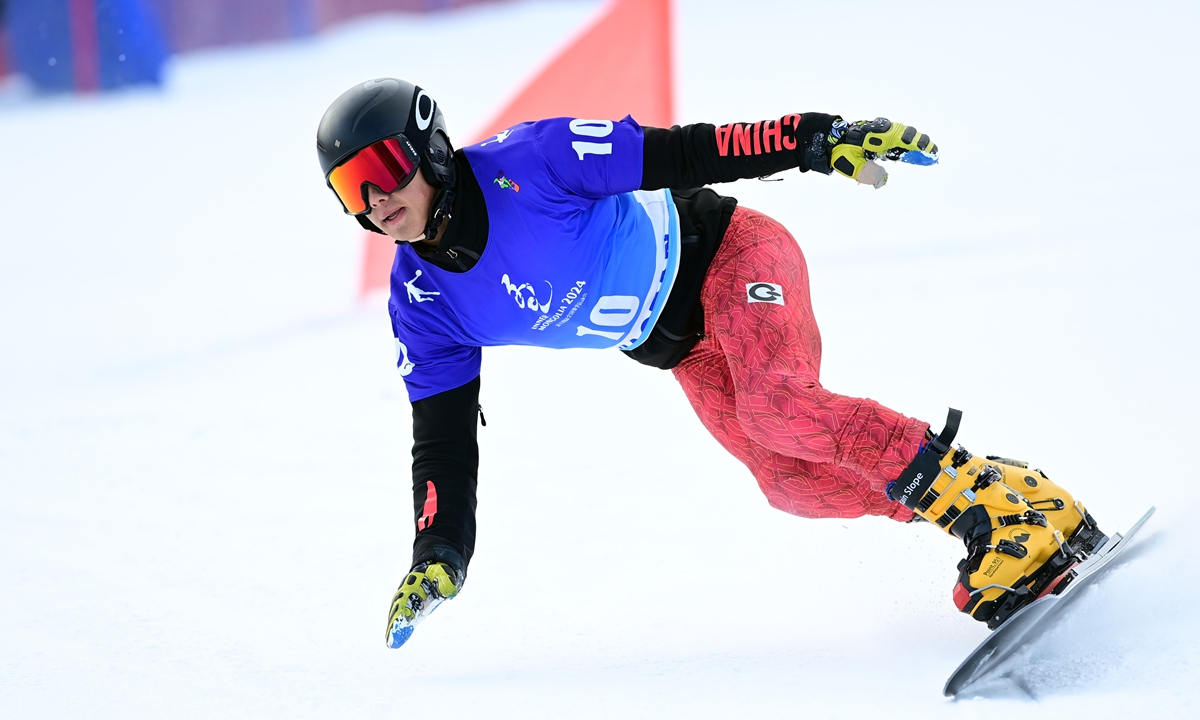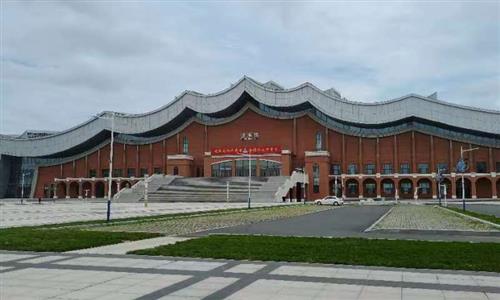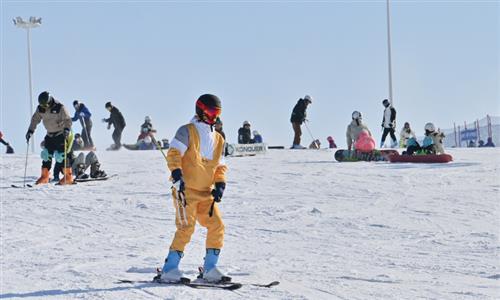
An athlete competes in the snowboard competition preliminary round at the National Winter Games on January 25, 2024. Photo: VCG
The sports authority of the Xizang Autonomous Region announced on January 29 that, for the first time, a delegation representing the region will participate in the National Winter Games set to run from February 17 to 27.
A total of 33 athletes from the region competed in the preliminary rounds, with 25 successfully advancing to the finals, according to the Xizang sports bureau.
By adapting to local conditions and various talent selection and exchange programs, Xizang has cultivated a group of winter sports athletes who have achieved outstanding results at domestic and international competitions.
The highest domestic winter multi-sport event in China, the 14th National Winter Games is set to be held in Hulun Buir, North China's Inner Mongolia Autonomous Region, from February 17 to 27 during Spring Festival celebrations.
The upcoming National Winter Games will see athletes from Xizang compete in three different events: ski mountaineering, snowboard cross and cross-country skiing.
With more than 3,700 athletes participating, it will be the largest National Winter Games in history.
As the first large-scale winter multi-sport event in China following the Beijing 2022 Winter Olympic Games, the 14th National Winter Games, whose events are aligned with the Milan-Cortina 2026 Winter Olympic Games, consists of eight categories, 16 sub-categories, and 176 minor events.
Olympic champions Wu Dajing and Xu Mengtao are on the star-studded list to compete for gold medals representing their provincial delegations. Short track speed skaters Liu Shaoang, Liu Shaolin and Lin Xiaojun will make their debut at the national games since transferring to China in recent years.
Thanks to the growing popularity of winter sports across the country, several southern provinces and regions, such as Sichuan, Chongqing and Guangdong, have established winter sports teams for the games for the first time.
The games are the latest effort to expand the milestone achievement of the Beijing 2022 Winter Games, which got "300 million people to participate in winter sports."
The coming games are expected to fuel mass participation in winter sports, especially for people from southern China, and inject fresh impetus into the development of the sports industry in Inner Mongolia, Xu Jie, a Beijing-based sports commentator, told the Global Times.
"Beijing 2022 Olympics has put the country on the fast track for winter sports development and the upcoming domestic and international events will surely help maintain that momentum. The Games in Inner Mongolia will have a lasting impact on the regional sports industry, and local residents will enjoy this rich legacy," Xu noted.
In 1959, the first National Games took place in Beijing, but winter events were not included. A comprehensive sports event for ice and snow was held separately in February that year, called the "1959 National Winter Games." Held in cities Harbin and Jilin in Northeast China, they were the first National Winter Games.
From 1976 to 2012, China held 10 National Winter Games, mainly in Northeast China's provinces Heilongjiang and Jilin. In 2016, the 13th National Winter Games were held in Northwest China's Xinjiang Uygur Autonomous Region, the first time they were held outside Northeast China.
At the closing ceremony of the 13th Winter Games, Inner Mongolia took over the flag, starting the preparation for the 14th edition. Due to the pandemic, the Games originally scheduled for early 2020 were postponed for four years.
To welcome visitors to the national games and boost the public's participation in winter sports, a wide range of ice and snow activities are in full swing in Inner Mongolia.
The 20th Ice and Snow Nadam Fair held in Hulun Buir in December attracted over 5,000 visitors from Russia, Mongolia, and Malaysia and across China despite severe cold weather. The event, which features archery, horse racing, wrestling, and a cultural exhibition, lasted about 30 days.
From January 13 to 14, in Inner Mongolia's capital city of Hohhot, over 400 athletes from 19 provinces and autonomous regions across the country participated in grassroots competitions of the National Winter Games, the first of its kind to set up mass competitions.
To encourage more teenagers to participate in winter sports, Inner Mongolia has implemented campus ice and snow plans, promoting courses such as skating and skiing at qualified primary and secondary schools.
As of now, more than 200,000 students from over 300 schools in the autonomous region are regular participants in ice and snow sports, according to a report by the People's Daily.


